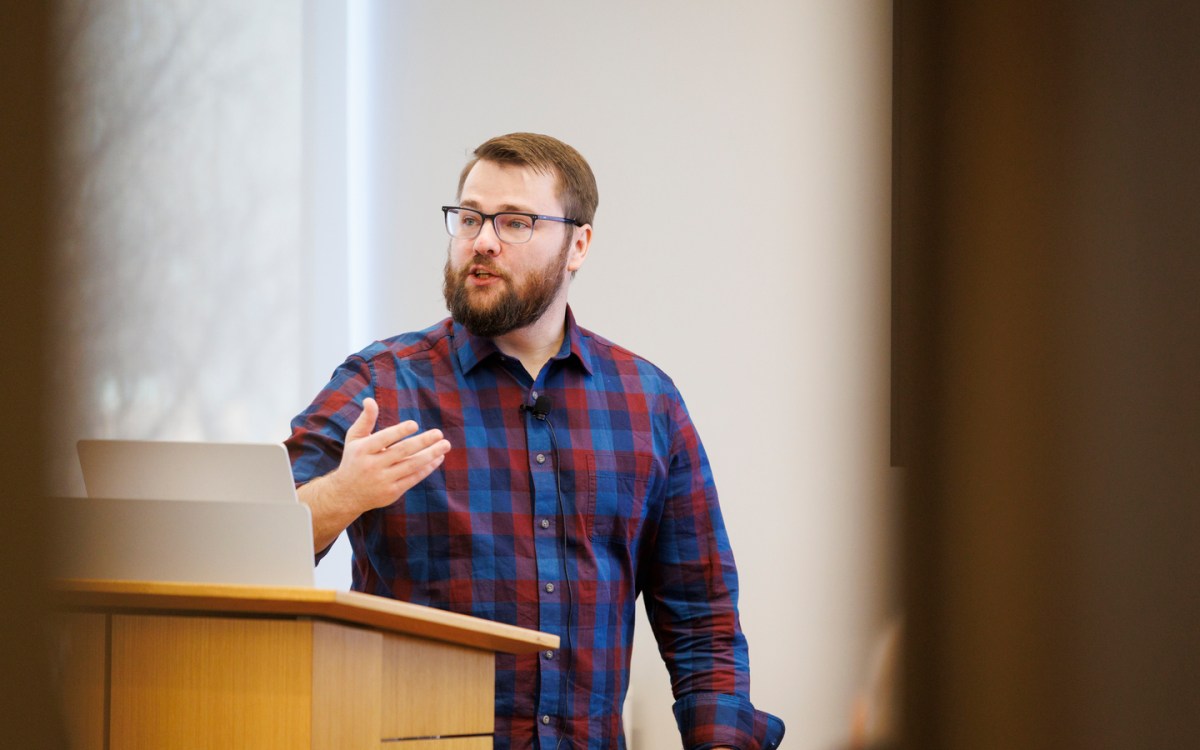Bringing hard science to economics
Guido W. Imbens, now in his first year as a professor of economics at Harvard, was still in high school in the Netherlands when he decided to study economics. For a bright, energetic boy who had always excelled at mathematics, there was nothing dismal about the so-called “dismal science.”
At Erasmus University in Rotterdam, Imbens studied econometrics, an academically rigorous combination of mathematical economics and statistics. The tools of econometrics are used to test economic theories using data, and to measure economic variables that are important for public policy.
Compared with classical mathematics, said Imbens, econometrics “appealed to me. It seemed more policy-relevant, more connected to the real world.”
This “appealing” concentration was also a grueling one. A typical freshman class at Erasmus might include 1,000 economics majors, but only 30 would concentrate in econometrics. “And after the first year, there would be 15 left,” said Imbens.
Erasmus put Imbens on an academic trajectory that not many years later included four American universities: Brown, where he got his Ph.D.; Harvard, where he began his teaching career in 1990; the University of California, Los Angeles, where Imbens earned tenure at age 33; and Berkeley, where he taught from 2002 until last year.
Coming back to Harvard last June, said Imbens, brought with it the thrill of returning to the intellectual environment where he first began a series of important collaborations.
For example, Imbens is already busy co-writing a book with Donald B. Rubin, Harvard’s John L. Loeb Professor of Statistics. It focuses on causality, a subject at the frontier of academic debate over research methodology in the social sciences.
Not long ago, statisticians would only talk about associations between potential causes and outcomes. That’s suggestive, but not conclusive, and left causation to a researcher’s subjective judgment. It also left policymakers guessing.
Today, with scholars like Imbens in the lead, the social sciences are using mathematical formulations to infer “causal relationships” from data. These methods are used to measure the effect of real-world interventions in drug treatment, training programs, health programs, or other arenas.
Proponents of the new research methods say they add rigor to economics, sociology, and other behavioral sciences that are trying to match the reliability of randomized trials. This gold standard of research is possible in medicine, but typically impossible in the social sciences.
Imbens and others use random or natural influences to enrich research designs in the social sciences. These “instrumental variables” exploit “natural experiments,” in which observable phenomena are used to mimic the rigor of a scientific experiment.
Imbens and Rubin, for example, used six years of data on lottery winnings in Massachusetts to study the effect of unearned income on labor earnings, savings, and consumption. It’s an important issue for policymakers considering — for instance — cash assistance to the working poor.
“We separated a lot of the assumptions, to clarify what you could learn,” said Imbens, who explains his methods in terms of “untangling” critical assumptions. “In the social sciences, there’s a great need for good statistical methods.”
This kind of work made Rubin “a big attraction in coming back” to Harvard, said Imbens. Their book about causality will get to the heart of improvements in methodology for social sciences research. “You can’t just be interested in correlation,” which is “only suggestive,” said Imbens. “It’s not clear what you learn. If things are not causal, there’s no policy implication.”
Coming back also gives Imbens the opportunity to participate in Harvard’s Institute for Quantitative Social Science (IQSS), where statistical and analytical tools are developed for the social and health sciences. It’s directed by political scientist and data software developer Gary King, Harvard’s David Florence Professor of Government. King called Imbens “the quiet and unassuming person in back of the room” — the one most likely to ask “the brilliant questions.”
Another attraction to Harvard was personal. Imbens’ wife, Susan Athey, also a professor of economics at Harvard, accepted tenure at the same time he did. She had been teaching at Stanford at the same time he was teaching at Berkeley. Now they live in Cambridge and walk to work, avoiding the two-city commute they had in California.
The busy couple has two children, one 3 years old and the other just 8 months. Household discourse is rarely about chi-squared statistics or covariates, said Imbens. “These days, at home, we talk child care.”
In his own childhood, Imbens enjoyed a sort of kitchen-table prelude to the rigors of academic life. In the 1950s, his father had studied mathematics at the university for a year before he had to drop out to make a living. But home became a mini-university for the three Imbens children, who were challenged to do long sums and play number games.
By his third year at Erasmus, Imbens was a research assistant in the university’s International Economics Group. That was also the year he spent in a seminar with visiting American mathematical economist Marcus Berliant, then at the University of Rochester.
“I ended up being the only student in his class,” said Imbens. The complexity of the class, he explained, chased away the other undergraduates.
A program at England’s University of Hull was originally just a one-year chance to study abroad, and “largely accidental,” said Imbens, who applied after a friend saw a notice on a school bulletin board. But Imbens stayed on for two years, and skipped his Dutch bachelor’s degree to take a master’s degree at Hull, studying with econometrician Anthony Lancaster.
Lancaster soon after moved on to Brown University, and had a momentous influence on the young Dutch scholar, bringing him from Hull to Brown to begin his Ph.D. studies.
“Tony Lancaster was really the one who got me interested in pursuing an academic career,” said Imbens of his mentor, who is still at Brown. “He made clear that this was actually a feasible thing, as well as a potentially exciting career.”




